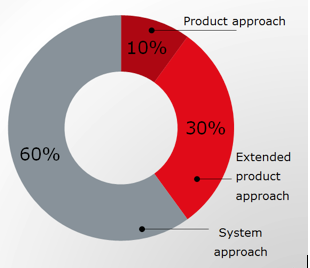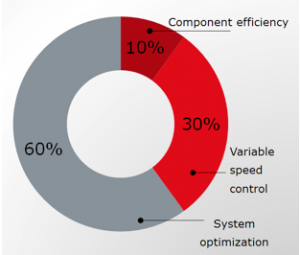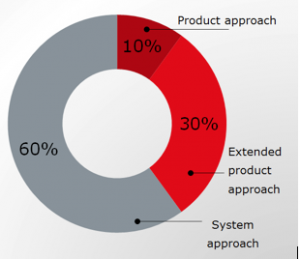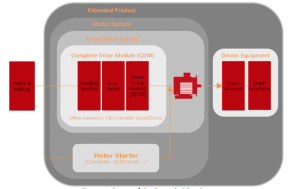
Embracing a systems philosophy in energy efficiency
February 17, 2017 | By Doug Backman
 Figure 2: Energy Savings Potential, legislation and standardization terminology
Figure 2: Energy Savings Potential, legislation and standardization terminology In the united effort to preserve global security of energy supply and protect the climate, the industrial sector is justifiably under intense scrutiny as a significant energy consumer. A focus on energy consumption, and therefore energy efficiency, is inextricably bound to energy security. Energy consumption can be significantly reduced by looking beyond improvements in components efficiency to a systems approach to efficiency.
“Efficiency First,” energy saved is an energy source in itself
Reducing consumption has just as great a role to play in ensuring a sustainable energy supply in the future as converting from fossil fuel to renewable energy sources or expanding energy supply capacity. Energy efficiency is not only crucial in reducing CO2 emissions and production costs; it is also a key enabler in ensuring a stable supply, because it reduces the need to expand the grid or build new power plants. What is not consumed is not transported, saving on expansion and maintenance of the associated grid infrastructure. Improving energy efficiency does require an upfront investment. However, in many cases this investment is more cost-effective or valuable than the equivalent supply-side resources. For example, an installation of variable speed drives at Holcim Cement slashed utility bills so significantly that the project payback period was less than two years.
It makes sense to talk about energy efficiency as an energy source – and the first source.
Some of the key ways in which “Efficiency First” can contribute to more cost-effective, competitive energy choices are:
- Enabling efficiency investments to compete on a level playing field with energy supply investments, in the national energy markets
- Removing barriers to investments in efficiency
- Taking account of energy efficiency in policy development and planning, and avoiding unnecessary investments in fossil fuel infrastructure
When the capacity of industrial facilities is upgraded through an “efficiency first” approach, system efficiency optimization becomes the first alternative in sourcing energy. Incentive and motivation to optimize system efficiency will decouple increased capacity from increased energy consumption. In many countries the link between increased GDP and increased energy consumption has already been broken. To achieve the best possible results, the prerequisites are:
- Benchmarking tools to compare the efficiencies of different systems and solutions
- Motor and control system independence of the AC drives, ensuring the freedom to achieve the best possible combination of components for optimal system efficiency
A component versus system approach
Within the industrial sector, the largest consumer of electricity, electric motor systems, accounts for the majority of the electricity demand, which creates a strong case for optimizing electric motor systems – for instance through variable speed drives, or AC drives, which the International Energy Agency (IEA) suggests should be made mandatory.
Electric motor-driven systems consume 45 per cent of global end-use electricity
Typically, the electric motor is a component in a motor system, responsible for the conversion of electrical power into mechanical power. In turn, this mechanical power drives equipment such as fans, pumps or compressors. Analysis by the IEA shows that electric motor-driven systems consume at least 7,000 TWh/year globally, which is roughly equivalent to 45 per cent of worldwide end‐use electricity consumption. Electric motor-driven systems are therefore the largest single consumer of end‐use electricity and a prime target for co-ordinated government policies on a global scale.
To date, political regulation of industrial energy consumption has only partly addressed the energy efficiency and energy-saving potential of motor driven systems. Existing initiatives address efficiency at the component level, setting minimum performance levels for motors, pumps, fans and other single pieces of equipment.
According to ZVEI, the German Electrical and Electronic Manufacturers’ Association, efficiency improvement at the component level can address about 10 per cent of the total savings potential. Using variable speed in applications with pumps, fans and compressors can address about 30 per cent of the total savings potential. However, the largest potential for energy savings lies in system level optimization, where 60 per cent of the total savings potential can be addressed.
A large untapped potential for energy saving can be harvested through energy-efficiency regulations that incentivize system-based optimization rather than just optimization at the component level.
Potential of the systems approach
The wide range of energy-reduction strategies fall into three general categories, with differing values. As stated above, the total energy reduction potential is split into three categories, which will now be addressed in more detail:
- 10 per cent by improving efficiency of components, such as motors, fans, and pumps
- 30 per cent by using speed control with AC drives, adapting to the variable load
- 60 per cent by optimizing the remaining system, such as piping and valves in a pumping station
The origins of energy savings potential in electric motor driven systems:

Figure 1: Energy Savings Potential, industrial terminology

Figure 2: Energy Savings Potential, legislation and standardization terminology

Figure 3: Scope of the Extended Product
An EU pump study under Ecodesign Lot 29 demonstrates that efficiency regulation based on the extended product approach has an energy savings potential seven to nine times greater than component efficiency regulation.
Overall system optimization comprises a multitude of different energy-saving approaches. All these factors influence the overall system efficiency:
- Analysis of the system layout
- The energy sources used
- Central or decentral control
- Degree of partial loading
- Actions which can reduce energy consumption
When choosing which combination of approaches to apply, it is vital to act on the basis of cost-effectiveness over the lifetime of the facility.
Partial load
In particular, partial loading is a critical issue addressed in system optimization but not in component-level optimization. Component efficiency measurements are based on full load. In reality, however, systems operate at varying partial loads where the efficiency levels of the components drop dramatically; this decrease in efficiency is addressed in measures for system optimization.
Even though system-level optimization offers the highest energy-saving potential, it is important that improving component efficiency not be overlooked. Efficient components will aid in providing motivation to improve the extended product efficiency and the system efficiency, and in achieving the greatest gains for the global energy supply.
How can we promote the extended product and system efficiency approaches? If businesses, trade organizations, and policymakers can agree on a universal benchmarking standard that takes partial loading into account, it will be easier to compare and assess the efficiencies of different system solutions.
System efficiency as market differentiator
In the U.S., pumping system operators will soon be motivated to optimize pump system efficiency by a voluntary labelling scheme. The Hydraulic Institute, a non-profit trade association of pump manufacturers and suppliers, is planning to introduce a voluntary labelling program that enables benchmarking of pump systems.
Using a standardized testing system, manufacturers can differentiate themselves by demonstrating the superior efficiency of their pump systems in terms that are comparable with competing systems. In this way, pumping industry suppliers are effectively motivated to optimize pump system energy efficiency ratings, without the need for government regulation.
In contrast to the Hydraulic Institute’s voluntary labelling program, The Energy Conservation Standards for Pumps uses a mandatory approach. Implementation of this regulation is predicted to reduce U.S. electricity consumption by 1 per cent in the period 2020-2045, due to pump system optimization alone. The standard states: The cumulative reduction in CO2 emissions through 2030 amounts to 2.7 Mt, which is equivalent to the emissions resulting from the annual electricity use of more than 0.37 million homes.
Challenge to legislators and regulators
Common wisdom among leading authorities within research and regulation says that effective regulation has to come in a well-defined order:
- Component efficiency regulation
- Once this is in place and completed, the extended product approach (the AC drive, motor and driven machine) is implemented
- Finally, the system approach can be implemented.
However, this approach does not address the “low-hanging fruit” first, although it seems easy from a regulatory point of view. Rather, all three areas should be addressed in parallel, using well-defined and suitable tools in each area.
System level optimization can without a doubt deliver the greatest energy savings. Therefore, the focus should not only be on optimizing component efficiency, but also on increasingly improving efficiency at the system level by applying the “extended product approach,” addressing the variable speed drive, the motor, the driven application, and its variable load.
Douglas K. Backman is the Vice President of Canada at Danfoss Drives. He is responsible for sales, service and operations, and also has P&L responsibility for Danfoss Drives in Canada. For more information, visit www.danfoss.us.
